What Are Different Types of Orchids

Orchids are a diverse and stunning group of flowers that have captured the attention of plant enthusiasts and collectors for centuries. Known for their exquisite beauty and unique forms, orchids come in a wide array of types, each with its own distinct characteristics.
From the exotic and rare to the common and easy-to-grow, orchids offer a captivating world for plant lovers to explore. In this article, we will delve into the fascinating realm of orchids, uncovering the different types of orchids that exist and their key features.
Most Types of orchids
Orchids grow throughout the world between the North and South Poles, excluding deserts, and between roughly 0 and 3,5000m in altitude. The USA has the biggest number of different species in Europe. Depending on the source, there are 25,000 and 35,000 different species, divided into 800 types. They are epiphyte (growing on other plants), lithophyte, (growing on rocks) in hot regions, or terrestrial in regions with a more moderate climate.
There are over 100,000 hybrid varieties, which are sold in most garden centers and which are very easy to grow. These are familiarly called “window sill orchids”. Reproduction by meristems, a sort of cloning, makes these types of orchids easily available. They are also easy to grow indoors. It is, however, useful to know the name of the orchid, or at least its type, to adapt its growing conditions to the environment.
Peacock orchid and Bletilla striata orchid bulbs are more and more common in garden centers in spring. These are Asian terrestrial orchids.
Botanical species can be bought from specialist orchid producers
Orchids like a high humidity level and the presence of other plants. They appreciate having their leaves bathed every day and a saucer of humid gravel or clay stones placed under their pot. They also like gentle ventilation but detest cold air currents which cause their flower buds to fall (for example, the Phall).
In winter they appreciate a maximum of light (put them on a window sill facing south, without shade). In March or April, they should be placed in the slight shade facing north (depending on the species and the latitude).
Terrestrial orchids sleep during the winter in cold and moderate countries. Those who grow in hot, dry countries, like Australia, may sleep in summer.
The Main Types of Orchids, Created to be Sold as cut Flowers, are:
- Phall and related types
- Dendrobium
- Boat orchids
- Paphiopedilum (Paph)
- Oncidium (Onc.)
- Blue orchids and related types
- Odontoglossum (Odm.)
- Cattleya
- Miltoniopsis (Mltnps)
- Epidendrum (Epi.)
The most common orchids growing in the wild are the Dendrobium and the Bulbophyllum (Bulb.), each consisting of between 1,000 and 1,500 species. There are different types of Orchids that have a diversified vegetal makeup:
1. Terrestrial Orchids Possess :
- either an underground tuber (Orchis, Dactylorhiza, Cypripedium).
- or apparent tubers called pseudobulbs (Himalayan Cymbidium).
- or roots at the base of the plant only (Paphiopedilum, exotic Cypripedium). This type of vegetation is called sympodial.
2. Epiphyte or Lithophyte Orchids Possess :
- either pseudobulb in various shapes and aerial roots that cling onto the plant or rock to feed themselves (sympodial orchids).
- or one leafy stem, which grows, and aerial roots (Vanda, Vanilla). These are monopodial orchids.
Read More: Indoor Plants That Can Thrive Inside Your Air-Conditioned Home
The Substratum For Orchids
The Substratum for Epiphyte Orchids
The nature of this substratum isn’t very important as its purpose is to support a plant that lives on a tree. It should be as inert as possible, ventilated, and it should retain an amount of water suited to the growing conditions of the plant in its original environment (thus it is important to know the name of the plant).
You Can Use
- horticultural pine bark, which lasts around 3 years.
- well-washed coconut fiber, which will get rid of sea salt (be careful of rot caused by over-watering).
- cork cut up into small pieces (wax-free wine corks).
- or a mixture of one of the above with polystyrene of different sizes, or with a small quantity of perlite or vermiculite (this helps roots to sprout).
Some epiphytes are sold in baskets. They may be reported to help them grow. Or you may simply place the basket in a suitable pot three-quarters full of humidified clay stones.
We could all go out of our minds trying to find a personal mixture – but it is much simpler just to use horticultural pine bark (not that used for embankments) of different particle sizes, depending on the thickness of the roots. Small particle size is suited to thin roots, medium, or big sizes to the others. Good stability and drainage can be obtained by putting 2cms. of clay stones or bits of broken pots at the bottom. If you suspect that the bark contains parasites or fungi, pour some hot water over it or boil it a bit to destroy these nuisances.
The Substratum for Terrestrial Orchids
It is much safer and simpler to buy the one sold for Cymbidium or boat orchids. You may add polystyrene for ventilation, if necessary.
Different Types of Orchids
Cattleya Orchids –
 The Queen of Orchids Cattleya orchids, also known as corsage orchids, are renowned for their large, showy flowers and delightful fragrance. Native to Central and South America, these orchids are often referred to as the “queen of orchids” due to their regal appearance.
The Queen of Orchids Cattleya orchids, also known as corsage orchids, are renowned for their large, showy flowers and delightful fragrance. Native to Central and South America, these orchids are often referred to as the “queen of orchids” due to their regal appearance.
Cattleya orchids come in a wide range of colors, from vibrant purples and pinks to soft pastels, and are highly prized by orchid enthusiasts and collectors for their exquisite beauty. However, they require more care and attention compared to other types of orchids, making them a favorite among experienced growers.
Vanda Orchids –
 The Tropical Marvels Vanda orchids are tropical orchids native to Southeast Asia and are known for their striking and vibrant flowers. These orchids are typically epiphytic, meaning they grow on trees and do not require soil to thrive.
The Tropical Marvels Vanda orchids are tropical orchids native to Southeast Asia and are known for their striking and vibrant flowers. These orchids are typically epiphytic, meaning they grow on trees and do not require soil to thrive.
Vanda orchids are characterized by their large, round flowers with bold colors and intricate patterns. They require specific care, including high humidity and bright light, making them more challenging to cultivate compared to other types of orchids. However, their stunning beauty and unique growth habits make them a prized possession for avid orchid collectors.
Miltoniopsis Orchids
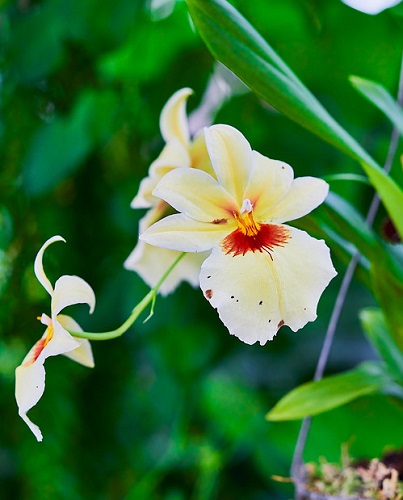 The Pansy Orchids Miltoniopsis orchids, also known as pansy orchids, are known for their unique and striking flowers that resemble pansies. Native to the cloud forests of Central and South America, these orchids thrive in cooler temperatures and prefer bright, indirect light.
The Pansy Orchids Miltoniopsis orchids, also known as pansy orchids, are known for their unique and striking flowers that resemble pansies. Native to the cloud forests of Central and South America, these orchids thrive in cooler temperatures and prefer bright, indirect light.
Miltoniopsis orchids typically have a single flower per stem and come in a range of colors, including whites, pinks, purples, and yellows. They are highly prized for their delicate beauty and charming appearance, making them a favorite among orchid enthusiasts who appreciate their unique characteristics.
Cymbidium Orchids
 The Winter Delights Cymbidium orchids are known for their large, robust flowers and are often referred to as the “king of orchids.” Native to Asia and Australia, these orchids are highly adaptable and can tolerate a wide range of temperatures, making them ideal for cooler climates.
The Winter Delights Cymbidium orchids are known for their large, robust flowers and are often referred to as the “king of orchids.” Native to Asia and Australia, these orchids are highly adaptable and can tolerate a wide range of temperatures, making them ideal for cooler climates.
Cymbidium orchids come in a variety of colors, including whites, yellows, pinks, and greens, and are often used in floral arrangements and corsages. They require specific care, including cooler temperatures during winter months to stimulate flower spikes, making them a popular choice among orchid enthusiasts who enjoy their winter blooms.
Lady Slipper Orchids
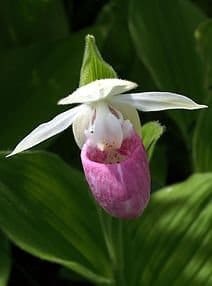
The Unique Gems Lady slipper orchids, also known as Paphiopedilum orchids, are characterized by their unique and exotic flowers that resemble a slipper or pouch. Native to Southeast Asia and parts of the Himalayas, these orchids are highly prized for their intricate flowers and diverse forms.
Lady slipper orchids come in a variety of colors and patterns, and their blooms can last for several weeks to several months. They are terrestrial orchids, meaning they grow in soil, and have specific care requirements, including moderate light and humidity levels.
Lady slipper orchids are considered a gem among orchid collectors, and their rare and distinct beauty makes them a sought-after addition to any orchid collection.
Paphiopedilum Orchids
Paphiopedilum orchids, commonly known as Lady Slipper orchids, are a unique and captivating group of orchids that are highly prized for their intricate and exotic flowers. These orchids are native to Southeast Asia and parts of the Himalayas, and they are known for their distinct slipper or pouch-shaped flowers that come in a variety of colors and patterns.
One of the most striking features of Paphiopedilum orchids is their flowers, which often have bold, colorful markings and intricate patterns. The pouch-like structure of the flower serves as a trap to attract pollinators, such as insects, who enter the pouch in search of nectar and become temporarily trapped. As the pollinator exits the flower, it brushes against the stigma, which results in pollination. This unique pollination mechanism has made Paphiopedilum orchids a subject of fascination among botanists and orchid enthusiasts alike.
Are easily suited for home growing, requiring only bright light and your normal home temperatures. Also called a slipper orchid and blooms are long-lasting up to 10 weeks of bloom.
Temperatures
Most mature orchids need about 15 to 20f temperatures between night and day.
Water
Never let plants dry out.
Fertilizer
Must be fertilized regularly, but requires less fertilizer than most orchids.
Potting
should be done about every one to two years. Use a good 10-10-10 balanced ratio.
Oncidium Orchids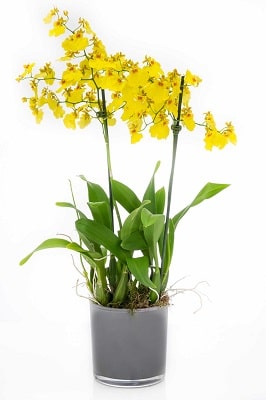
Oncidium Orchids – The Dancing Beauties Oncidium orchids, commonly known as dancing lady orchids, are known for their intricate and eye-catching flowers that resemble dancing figures.
These orchids are native to various regions, including Central and South America, and are often characterized by their cascading sprays of flowers with distinctive patterns and bright colors.
Oncidium orchids are relatively easy to care for and can be grown both indoors and outdoors, making them a popular choice for orchid lovers.
Temperatures
should be 55-60f at night and 80 85 during the day.
Water
Generally, plants with large fleshy roots need less water. Watering should be thorough. Plants not active should be watered less.
Fertilizer
Apply a good 30-10-10 balanced fertilizer twice a month.
Potting
Re-pot when the plant is about half mature. Keep Humidity high and the new pot should be medium dry until new roots form.
Dendrobium Orchids
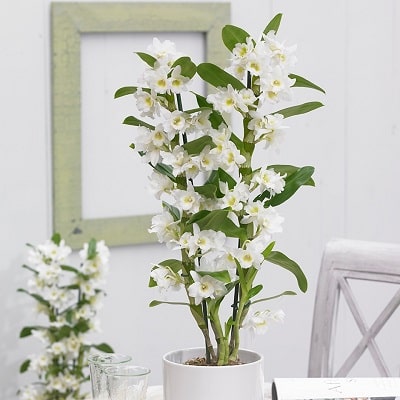
Dendrobium Orchids – The Diverse Beauties Dendrobium orchids are a diverse group of orchids that are native to various regions, including Asia, Australia, and the Pacific Islands.
These orchids are known for their unique forms, with some producing cane-like stems and others bearing sympodial growth. Dendrobium orchids come in a wide array of colors, shapes, and sizes, ranging from small miniatures to large, showy flowers.
They are adaptable and can thrive in a range of environments, making them a popular choice among orchid enthusiasts.
Temperatures
Mature plants like a 15 to 20 f difference between night and day. Leaves may drop if temperatures drop below 50f.
Water
They like moist soil but can tolerate dryness when the plant is matured.
Fertilizer
They like to be fertilized often, especially during the growing period. Use a good 10-10-10 balanced ratio.
Potting
Repot every 2-3 years, give good aeration and drainage. They tend to like small pots for their size.
Phalaenopsis orchids
The Beginner’s Delight Phalaenopsis, commonly known as the moth orchid, is one of the most popular types of orchids among beginners and experienced growers alike. These orchids are native to Southeast Asia and are known for their vibrant colors, long-lasting blooms, and ease of care.
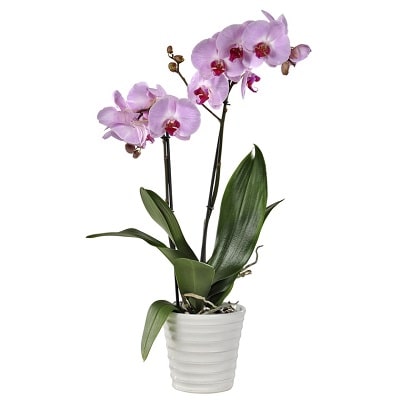
Phalaenopsis orchids typically have thick, fleshy leaves and produce cascading spikes of flowers that can last for several months. They are well-suited for indoor cultivation and make excellent houseplants, adding a touch of elegance to any space.
Orchid-phalaenopsis
It is a favorite among orchid care enthusiasts. Long-lasting blooms with many colors and are inexpensive.
Temperatures
Needs about 15 to 20 F. Seedlings need about 10 degrees higher than mature plants.
Water
Do not let plants dry out. Younger plants need more watering and attention.
Fertilizer
Should be fertilized regularly. A good 10-10-10 or similar ratio. Fertilize every week at one-quarter to one-half of the recommended dilution.
Potting
Should be done every 2-3 years. Better if done during late spring.
Remember always use a good orchid care fertilizer and soil for all types of orchids. Typically the above orchids are what most nurseries have, but there are over 28,000 varieties.
Caring for Orchid Flowers
Taking care of orchids mainly focuses on maintaining a balance of growth requirements such as light and water preferences as well as a growth medium as stated below:
i. Judging by the type of orchid that you choose you will know what amount of light intensity to subject it to. Take note, orchids are light-hungry plants, you should, therefore, make sure your orchids are exposed to at least 12 hours of sunlight every day all year long.
ii. Find out at which height the orchid you intend to grow to be planted and its soil type preference. The best way to do this is to consult orchid horticulturalists. Alternatively, you can check on the Internet.
iii. Grow your orchids in properly ventilated places. This is very important as it will ensure that the plants are exposed to adequate air and humidity.
iv. Orchids are known to thrive in quality soils. You should, therefore, make sure that the soil in which you intend to grow your orchids is rich in nutrients. Feel free to also fertilize the soil regularly as the orchids continue growing. Remember orchids tend to thrive best when the 30-10-10 special orchid fertilizer or urea-free fertilizer that is soluble in water is applied.
v. Water is an essential requirement for the growth of plants. However, for orchids, it is considered a special requirement for growth. In such a case, make it a priority to adequately water your orchids. While doing this make sure the pot used has good drainage properties. Also, make sure not to leave any stagnant water each time you finish watering.
vi. Despite being tropical plants closely monitor your orchids in the process making sure they are exposed to an adequate temperature, especially during night times (which are normally characteristic of temperature fall). This way the soil will remain moist around the clock.
vii. Create time to prune your orchid at given intervals preferably once every six months or at the start of a different season. This is important to give them the desired aesthetic shape. You will also be able to get rid of dead parts.
Conclusion
In conclusion, orchids are a captivating and diverse group of flowers that offer a world of beauty and wonder for plant enthusiasts. With their stunning flowers, unique forms, and varying care requirements, different types of orchids provide endless opportunities for orchid lovers to explore and appreciate their splendor.
From the popular and easy-to-grow Phalaenopsis orchids to the exotic and rare Lady Slipper orchids, each type of orchid has its own distinct characteristics that make it a prized possession for plant collectors. By understanding the key features and care requirements of various types of orchids, you can embark on a journey of discovering the unparalleled beauty of these exquisite flowers.
I hope you found this comprehensive guide to different types of orchids informative and engaging. Whether you are a beginner or an experienced orchid enthusiast, I hope this article has provided valuable insights into the world of orchids and inspired you to further explore and appreciate the enchanting beauty of these remarkable flowers. Happy orchid growing!










